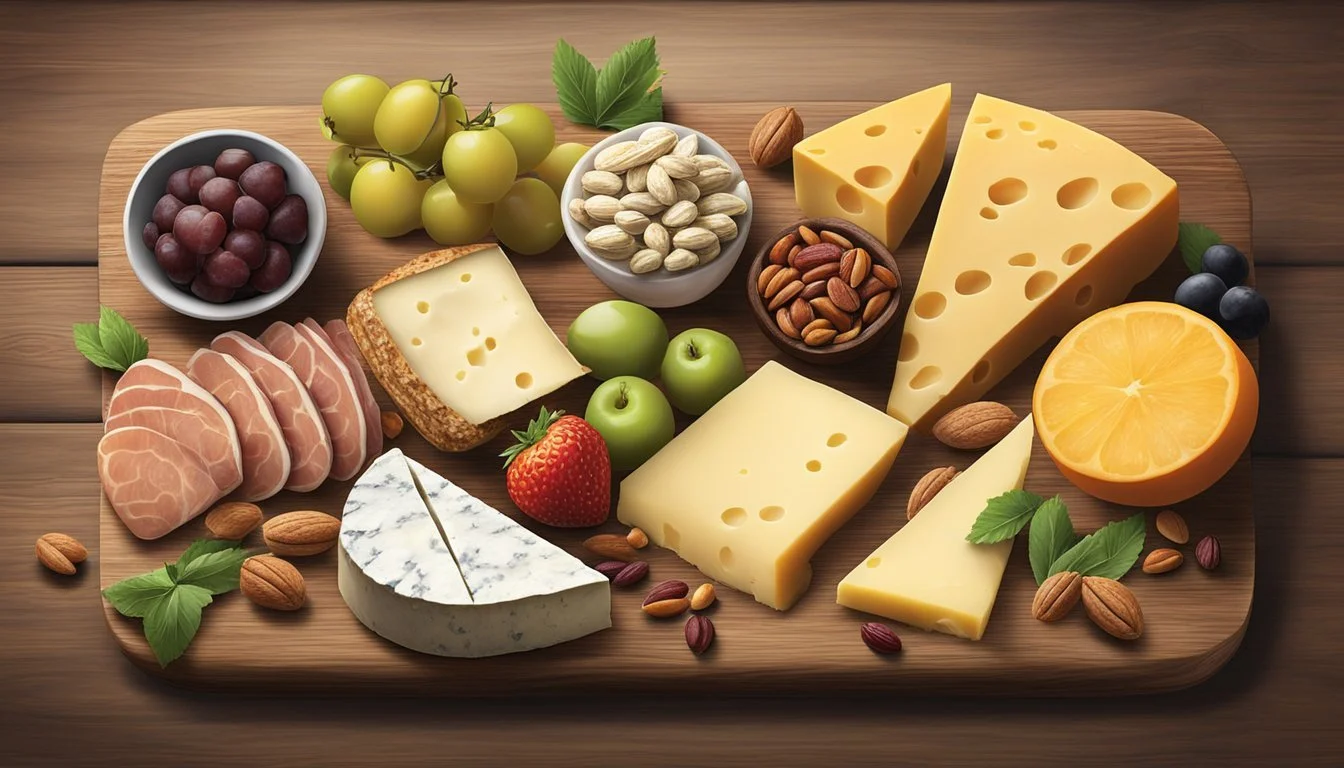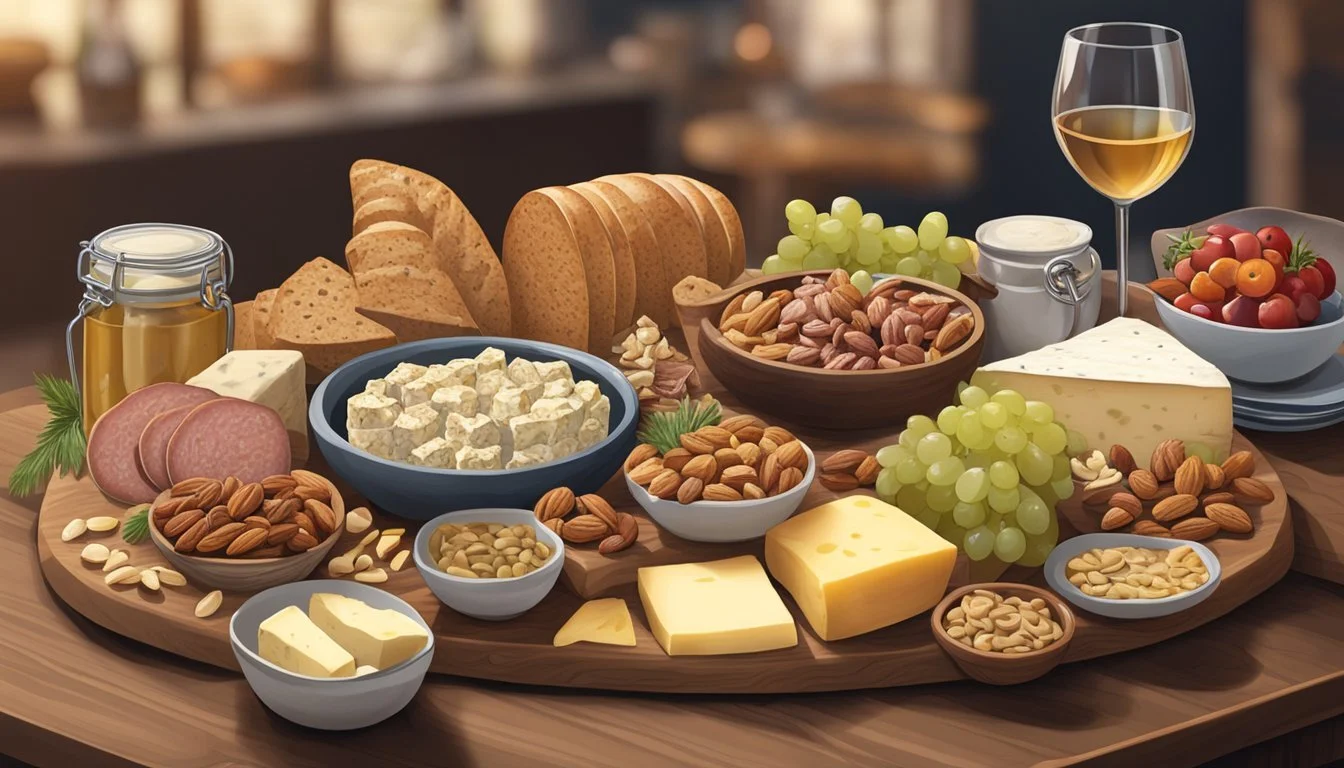How do you eat charcuterie?
A Simple Guide to Enjoying Artisan Meats and Cheeses
Charcuterie (What wine goes well with charcuterie?) boards offer a medley of flavors and textures, allowing diners to explore a variety of cured meats (What wine goes well with cured meats?), cheeses (how long does cheese last?), and accompaniments. Traditionally, they stem from the French culinary arts, where 'charcuterie' refers specifically to the preparation of meats. Today, these boards are not only a display of gastronomic craftsmanship but also a social centerpiece, perfect for gatherings where guests can graze at their leisure.
Eating from a charcuterie board does have its nuances to enhance the experience. Thinly sliced meats are paired with different cheeses, crackers, nuts, fruits, and spreads to create a balanced bite. It's common for guests to use their hands, complemented by utensils like toothpicks or small tongs to assemble each personalized morsel. Small bowls with spoons may be included for sauces and dips, allowing individuals to add flavors to their selections without creating a mess.
As charcuterie boards have gained popularity, they’ve evolved to fit various meal contexts, from appetizers to main courses. A well-constructed charcuterie board invites diners to experiment with combining flavors while enjoying the company and conversation. It’s a way of dining that celebrates variety and encourages a relaxed, communal approach to eating.
Assembling Your Charcuterie Board
A well-assembled charcuterie board combines a variety of flavors and textures, balancing the selection of meats, cheeses, and accompaniments to create an appetizing presentation.
Choosing the Right Board
One should select a board large enough to accommodate the variety of items without overcrowding. Common materials include wood and slate, which not only serve a functional purpose but also enhance the overall presentation. The size of the board will be dependent on the number of guests.
Arranging the Meats
For the meats, one should aim for a mix of cured meats such as salami and prosciutto, alongside other options like ham. Meats can be folded, rolled, or sliced and should be arranged around the board with adequate space between each type.
Selecting a Variety of Cheeses
Choose a range of cheeses in both flavor and texture. Soft cheeses (What wine goes well with soft cheeses?) like brie sit alongside firmer choices such as manchego. Cutting some cheeses into slices or wedges allows for easy serving, while others can be presented whole with a knife for guests to cut their own portions.
Adding Fresh and Dried Fruits
Intersperse fresh fruit like berries and dried fruit amongst the meats and cheeses, adding both color and a sweet counterpoint to the savory flavors. They can also act as palate cleansers between different tastes.
Incorporating Nuts and Olives
Bowls of nuts and olives can be placed on the board or alongside it to provide a crunchy, briny contrast to the meats and cheeses. Almonds, cashews, or walnuts are popular choices.
Including Crackers and Breads
Finally, various breads and crackers should be included to complement the cheeses and meats. Thin slices of baguette, artisanal crackers, or small breadsticks give guests a means to sample the array of sauces and spreads available on the board.
Complementing Textures and Flavors
When it comes to eating charcuterie, the magic lies in how one pairs varying textures and flavors to create a harmonious experience. Strategic pairing can amplify the distinct qualities of each component.
Pairing Cheese with Accompaniments
The foundational rule in pairing cheese is to balance its richness with contrasting or complementary accompaniments. For soft cheeses like brie or goat cheese, fruit jams and honey offer a delightful sweetness, enhancing their creamy texture. In contrast, hard cheeses such as cheddar or gruyere pair well with pickled vegetables (What wine goes well with pickled vegetables?) or mustard, providing a sharp textural contrast and a burst of flavor.
Soft Cheese Accompaniments:
Brie: Fig jam, apple slices
Goat Cheese: Olives, honey drizzle
Hard Cheese Accompaniments:
Cheddar: Spicy mustard, salted nuts
Gruyere: Caramelized onions, grainy bread
Balancing Sweet and Savory Elements
One should artfully balance sweet and savory elements to excite the palate. Adding fruits like grapes or figs brings a natural sweetness that can counteract the savory depth of Italian salami or prosciutto. Honey and savory herbs offer a multi-dimensional taste profile when drizzled or sprinkled over cheeses and meats.
Sweet Elements:
Grapes, figs, apricots
Jams: Berry, apricot, or fig
Savory Elements:
Italian Meats: Salami, prosciutto
Herbs: Rosemary, thyme
Considering Texture Contrasts
A satisfying charcuterie experience often hinges on the intentional combination of different textures. Creamy soft cheese contrasts beautifully with the crispness of crackers, while the chewy qualities of cured meats are offset by the crunch of fresh vegetables or nuts.
Texture Contrasts:
Creamy: Brie, camembert
Crispy: Artisan crackers, breadsticks
Catering to Different Dietary Preferences
Incorporating different dietary preferences is key to an inclusive charcuterie board. For vegetarians, an assortment of cheeses, nuts, and fruit ensures they enjoy a range of textures and flavors. Vegan options might include non-dairy cheese alternatives, marinated tempeh, and a wide variety of fruits and vegetables.
Vegetarian Options:
Cheese: Blue cheese, Swiss cheese
Fruits and Vegetables: Bell peppers, cherry tomatoes
Vegan Options:
Non-Dairy Cheese: Soy-based, almond-based
Plant-Based Proteins: Marinated tempeh, spiced chickpeas
The Art of Serving Charcuterie
A charcuterie board combines an array of meats, cheeses, and accompaniments, where the visual appeal is almost as important as the taste. The key to a successful charcuterie board lies in the presentation, appropriate temperatures, portion sizes, and ensuring the freshness of the offerings for the duration of the event.
Arrangement and Presentation Techniques
A charcuterie board should be both aesthetically pleasing and functional. Start with a sturdy base like a marble board, which not only looks elegant but also maintains a cool surface temperature. Meats should be thinly sliced and folded or rolled for easy grazing, while cheeses can be cut into various shapes and sizes for visual interest. The arrangement should encourage guests to create their own flavorful combinations. Distribute color by adding fresh fruits and small bowls of dips to break the monotony and add vibrancy.
Meats: Folded or rolled, arranged around the board's edge
Cheeses: Various shapes, centrally placed
Fruits/Dips: Distributed for color, in small bowls
Maintaining the Correct Temperature
Temperature plays a vital role in serving charcuterie. Cured meats and most cheeses should be served at slightly below room temperature to enhance their flavors. If serving outdoors, consider placing the charcuterie board in a shaded area or over a cooling rack to prevent overheating. One can also periodically swap in chilled replacements for items that have been sitting out too long.
Meats/Cheeses: Slightly below room temperature
Outdoors: Shaded area, cooling rack, chilled replacements
Serving Size and Portioning
For portioning, a good rule of thumb is to allocate about 2 ounces of meat and cheese per guest. Pre-slice the meats and cheeses to encourage self-service without overcrowding the board. Each guest should be able to access every item easily, without the need to reach over or disassemble the presentation.
Meats/Cheeses: 2 ounces per guest
Pre-slicing: Facilitate easy serving and access
Ensuring Freshness Throughout the Event
To ensure that everything on your charcuterie board remains fresh, avoid placing out the entire supply of your offerings from the start, especially if the event is lengthy. Instead, replenish the board with fresh items periodically. Keeping backup dishes refrigerated until needed will help maintain freshness and quality for your guests.
Replenishment: Periodic, based on duration
Backup Dishes: Refrigerated until serving
Ideal Pairings and Accompaniments
Selecting the right pairings and accompaniments can transform a charcuterie experience. The key is balancing flavors and textures, ensuring the chosen items complement rather than overshadow the meats and cheeses.
Selecting Wines and Beverages
Pairing wine with charcuterie is an art that enhances the tasting experience. For fatty meats and bold cheeses, full-bodied red wines like Cabernet Sauvignon or Syrah cut through the richness. Alternatively, lighter meats pair well with crisp whites like Chardonnay or Sauvignon Blanc. These wines often contain notes of fruits such as grapes and berries, which can add a subtle complexity to each bite.
Red meats: Full-bodied red wines (e.g., Cabernet Sauvignon)
Light meats: Crisp white wines (e.g., Sauvignon Blanc)
Choosing Complementary Spreads and Dips
Spreads and dips bring moisture and varied flavor profiles to the charcuterie board. Hummus provides a creamy texture that complements both meat and cheese. Traditional fruit jams, such as fig or strawberry, add a sweet contrast to savory items. For a more robust option, duck paté offers a rich, smooth accompaniment.
Spreads: Fruit jams (fig, apricot), hummus, duck paté
Adding Gourmet Items and Exotic Flavors
A charcuterie board should tantalize the senses with an array of taste sensations. Consider adding exotic flavors like cornichons—small, tart pickles—or a lightly spiced fruit compote. Gourmet items such as artisanal butter, finely sliced duck breast, or rare cheeses turn a simple board into an exquisite culinary adventure.
Exotic: Cornichons, spiced fruit compote
Gourmet: Artisanal butter, sliced duck breast
In adding these elements, the board becomes a palette for gastronomic exploration, where each chosen component plays a vital role in the overall tasting journey.
Etiquette and Techniques for Eating
Successfully navigating the social and culinary aspects of enjoying a charcuterie board includes using appropriate tools, constructing flavorful combinations, and understanding the nuances of social dining settings.
Using Utensils and Hands
Utensils: Guests should use the provided toothpicks, mini skewers, or small tongs to pick up bite-sized items. It's important to handle items like cheeses and meats without directly touching them to maintain hygiene.
Hands: For hard cheeses and bread, hands are acceptable. However, softer cheeses should be transferred with a utensil to avoid a mess.
Creating Perfect Bites
Combination: To fully appreciate the taste and texture, guests should combine flavors and textures. Thin slices of meat pair well with various cheeses and breads, creating a harmonious bite.
Texture: The consideration of texture is critical when assembling bites; crisp crackers complement the soft textures of pâtés or creamy cheeses, enhancing the overall sensory experience.
Navigating Social Settings
Party Etiquette: In a party setting, it’s courteous to ensure that each guest can access the board easily. Taking a small amount at a time avoids depleting the board quickly, allowing all guests to enjoy the assortment.
Tips: If the charcuterie serves as an appetizer, sampling small amounts leaves room for subsequent dishes. Additionally, slow, mindful consumption allows one to savor the variety of flavors offered on the charcuterie board.
Culinary Exploration and Variations
Charcuterie boards offer a canvas for creative expression in food, allowing for a fusion of international styles, thematic presentations, and accommodations for dietary preferences. They invite one to navigate through a rich landscape of flavors and textures.
Experimenting with International Styles
Italian charcuterie often features a variety of cured meats such as prosciutto, soppressata, and mortadella, which are paired with cheeses like mozzarella and Parmigiano-Reggiano. French selections may focus on options like pâté, rillettes, and a wide range of saucisson. Both styles embrace the use of fresh or pickled vegetables, bringing a brightness to counterbalance the richness of the meats, and perhaps a sprinkle of herbs to add a hint of freshness.
Innovative Charcuterie Themes
Themed charcuterie boards create an immersive tasting experience. One might assemble a board that plays with the juxtaposition of sweet and savory elements, balancing cured meats like pork-based salami with sweet accompaniments such as fig jam or honeycombs. Another approach can focus on spicy flavors, incorporating meats enriched with spices and matched with zesty veggies and bold spreads.
Vegetarian and Vegan Options
In response to dietary preferences, charcuterie boards have evolved to include vegetarian and vegan alternatives. Meats can be substituted with marinated and grilled vegetables, (What wine goes well with grilled vegetables?) while nuts and legumes can provide a rich, meaty texture. Vegan "meats" made from soy or gluten, seasoned with herbs and spices, can mimic traditional cured meats, ensuring that everyone can partake in the charcuterie experience.





